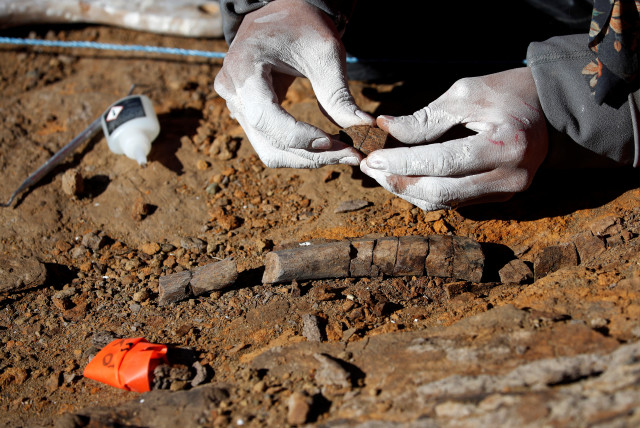New dinosaur species discovered in Zimbabwe highlights Africa's paleontological potential

Scientists discovered new dinosaur species, in Zimbabwe. The herbivorous dinosaur's remains date back to the late Triassic Period, highlighting Africa's paleontological potential
International scientists discovered the fossilized remains of a previously unknown species of dinosaur in Zimbabwe, Phys.org reported on Thursday.
The research was an international joint effort by scientists from the University of Witwatersrand (Wits) in South Africa, the Natural History Museum of Zimbabwe, Stony Brook University in New York and was led by Prof Paul Barrett from the Natural History Museum in London. The findings were published in the open access - quarterly peer-reviewed - academic journal Acta Palaeontologica Polonica.
The fossilized remains of the fourth species from Zimbabwe were found on the shoreline of Lake Kariba among rocks dating back to the late Triassic Period, roughly 210 million years ago. The new species has since been named Musankwa sanyatiensis - after the houseboat "Musankwa” where the research team based their operations.
The remains discovered included a single hind leg, including its thigh, shin, and ankle bones.
"Despite the limited fossil material, these bones possess unique features that distinguish them from those of other dinosaurs living at the same time," said Dr. Kimberley Chapelle, assistant professor at Stony Brook University and an honorary associate at the Evolutionary Studies Institute at Wits.
Missed potential
The Musankwa sanyatiensis was a herbivorous member of the Sauropodomorpha, a group of bipedal, long-necked dinosaurs and weighted approximately 390kg.
"The main reason for the underrepresentation of African dinosaur fossils is 'undersampling,'" one of the researchers explained. "Put simply, there have been fewer people looking for and unearthing dinosaurs [in Africa compared] with other regions of the world."
However, the limited discoveries of fossils in Africa were historically and scientifically significant, the report noted, as they included some of the oldest dinosaurs discovered thus far. Furthermore, the report argued the discovery highlighted the potential of central Africa for further archeological research.
"Over the last six years, many new fossil sites have been recorded in Zimbabwe, yielding a diverse array of prehistoric animals,” noted Barrett.
"Based on where it sits on the dinosaur family tree, Musanwka sanyantiensis is the first dinosaur of its kind from Zimbabwe," Dr. Chapelle stated. "It, therefore, highlights the potential of the region for further paleontological discoveries."
Jerusalem Post Store
`; document.getElementById("linkPremium").innerHTML = cont; var divWithLink = document.getElementById("premium-link"); if (divWithLink !== null && divWithLink !== 'undefined') { divWithLink.style.border = "solid 1px #cb0f3e"; divWithLink.style.textAlign = "center"; divWithLink.style.marginBottom = "15px"; divWithLink.style.marginTop = "15px"; divWithLink.style.width = "100%"; divWithLink.style.backgroundColor = "#122952"; divWithLink.style.color = "#ffffff"; divWithLink.style.lineHeight = "1.5"; } } (function (v, i) { });

